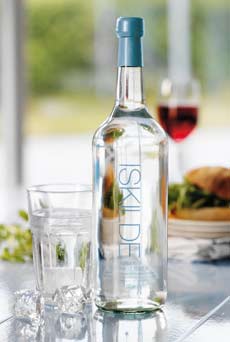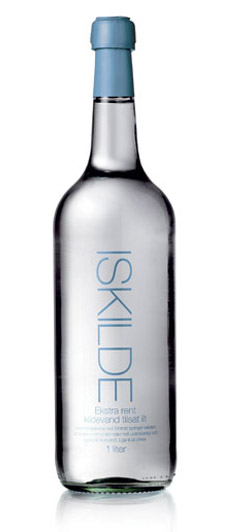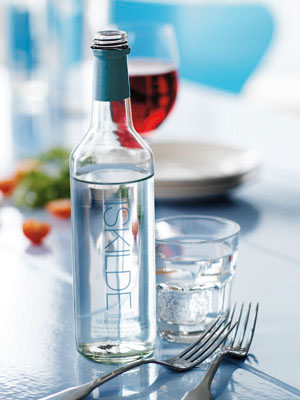

Iskilde is drawn from an artesian aquifer discovered in Denmark in 2001.
|
KAREN HOCHMAN is Editorial Director of THE NIBBLE.
|
|
July 2007
|
 |
Iskilde Mineral Water
Bottled Water From The Danish Highlands
CAPSULE REPORT: Pure Iskilde is pumped from an icy-cold aquifer in the remote highlands of Denmark. The naturally still water is very creamy. When carbonated, it is like Champagne: The bubbles are quite remarkable. It may be our favorite carbonated water. The handsome bottles make a fine house gift—reason enough to buy a few cases.
In 2001, in a remote part of the the Mossø Reservation area of the Danish lake highlands, a retired couple stumbled across an unknown water source not far from their farm. They named it Iskilde, “cold spring,” after the water was determined to be less than eight degrees Celsius (46°F—the average temperature of ground water in Denmark falls between 8°C and 12°C). The silky texture of the water inspired the husband, a retired insurance broker to bring it to market. Iskilde was released commercially in 2005. While this is quite recent, the water itself may possibly date back to the last ice age.
In addition to being a very cold spring, Iskilde has other unusual properties. The reservoir of the artesian aquifer* lies 150 to 180 feet below the ground. The water is under so much pressure that it would spout to the surface as a fountain, if allowed to rise on its own. The fact that the reservoir is under such pressure means that it is closed to the penetration of new water—one of the reasons why the water is so pure.
*An aquifer is an underground layer of water-bearing permeable rock, or permeable mixtures of unconsolidated materials like gravel, sand, silt, or clay. An artesian aquifer is a confined aquifer whose water is pressurized. Water will thus flow out of an artesian well without pumping. See our Water Glossary for more water terms and definitions.
Flavor Profile
Iskilde water is hard, with a medium minerality. To better understand this concept, study the charts in all of our mineral water reviews. You’ll see how the Total Dissolved Solids—minerals and other elements—compare, as well as the levels of specific minerals, like calcium, iron, sodium and sulphates. Each of these brings its own flavor to the water, so when it is resident in high quantity, it will impart its specific calcium, iron, salty, etc. characteristic to the water.
Iskilde is almost sweet in flavor. We found that it had a creamy, milky taste as well—both flavors a result of the high levels of bicarbonate, plus a complex mix of other minerals (more about those in a moment). The minerals are much more apparent when the water is consumed at room temperature: As wine connoisseurs know, cold covers up flavor nuances, so the best way to enjoy fine bottled water is chilled, but not ice cold.
The aquifer from which the spring flows is covered by alternating layers of quartz-sand and hard clay.
 Waters from the Danish lake highland region have a fairly high content of minerals, and tend to be almost sweet in their taste. Waters from the Danish lake highland region have a fairly high content of minerals, and tend to be almost sweet in their taste.- This is due to the influence of the different layers of soil. As it sieves through these layers, the water absorbs a wide variety of minerals. This bounty of minerality contributes to the body of the water, and also its perceived sweetness.
While the still water may be sweet and creamy, it is also sold in a sparkling version that Champagne lovers will find a total delight. The carbonation replicates the tiny bubbles of Champagne, and they don’t dissipate: We have returned to half a bottle the next day to find it as effervescent as when just opened. We have always preferred sparkling to still water, and have a feeling that Iskilde sparkling will become our new favorite water.
We go to a restaurant where tap water is served by filling the glasses once, and then placing a water-filled glass bottle on the table so diners can help themselves to refills. The beautiful Iskilde bottle is reason enough to take up this practice at home: Reuse the water bottle to serve tap water to your family. Perhaps they’ll drink more water when it’s poured from such an attractive vessel. The bottle was created by renowned Danish designer, Jesper Mathiesen.
Recently, we brought one liter bottles of both the still and sparkling Iskilde waters as a house gift, packaged in a handsome tote of handmade paper—the type used for gifts of wine. The host could not have been happier if we had presented him with two bottles of a top vintage.
| WATER |
Iskilde Mineral Water |
| Origin |
Mossø Reservation, Denmark
|
| Type |
Still and Sparkling |
| WATER ANALYSIS |
mg/l |
| TDS* |
426.0 |
| pH Factor |
7.7 |
| Bicarbonate |
246.0 |
| Calcium |
63.0 |
| Chlorides |
94.0 |
| Fluordine |
0.28 |
| Hardness |
Very Hard |
| Iron |
0.0 |
| Magnesium |
6.8 |
| Nitrate |
0.0 |
| Potassium |
2.7 |
| Sodium |
70.6 |
| Sulphates |
30.0 |
| |
|
*TDS = Total Dissolved Solids
ISKILDE MINERAL WATER
Still and Sparkling
- 500ml Bottles
Case Of 16 Bottles
$36.00
- 1-Liter Bottles
Case Of 9 Bottles
$33.00
Purchase online at Aquabar.ws
For more information about Iskilde, visit Iskilde.dk
Prices and product availability are verified at publication but are subject to change. Shipping is additional.
|
 |

|





